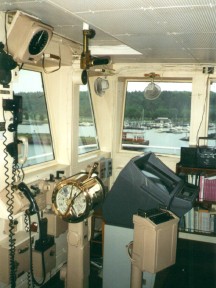
Well above average temperatures will prevail across the Plains and the West Coast this week, while a cold front will bring Arctic air to the South and East Coast Thursday and Friday. Lake effect snow is forecast downwind of the Great Lakes through Thursday along and behind the Arctic front, as well as mountain snow across the Southern Appalachians. Read More >
 |
||
Marine Communications
A view of the bridge aboard the Lee A. Tregurtha.
Marine communication through the years Since 1975, many methods have been developed to communicate marine warnings, statements, forecasts, and observations. In 1975, the main methods to send out NWS marine products were VHF voice radio, MF (Medium Frequency) radio telephone, and commercial AM marine radio stations. Today there are multiple ways to gather weather information for commercial mariners and recreational boaters. In 1975, communications between ships or from ship-to-shore were carried out by either VHF radio or an MF radio telephone. Any marine warnings, statements, and forecasts were disseminated by the Coast Guard on VHF radio. Today, the VHF radio still is a major player in communicating NWS marine products as Open Lake forecasts are broadcast twice daily over VHF radio. However, there are now many other methods of getting marine products, including via the internet through cell phones and satellite phones. Data availability including online and NOAA Weather Radio Both text and graphical products - specifically tailored to each of the Great Lakes - are available to commercial and public mariners, including the entire Open Lake text forecast and MAFOR for each Great Lake as well as forecast and modeled wind and wave height graphics out to 7 days. On the Great Lakes Marine Web Portal, you can find gridded and text weather and water information for the entire Great Lakes region. In addition, a point forecast for anywhere on the Great Lakes is accessable from the National Weather Service homepage at https://www.weather.gov. Just click on the marine area you are interested in. Access to real time buoy and CMAN station observations is available from the NDBC web site.
Additional options If a boater seeks more detailed buoy and CMAN station weather information, the National Data Buoy Center's (NDBC) Dial-A-Buoy telephone service is another viable source. Through Dial-A-Buoy, the mariner can obtain the latest meteorological and oceanographic data from a telephone recording updated hourly. To reach Dial-A-Buoy call As you can see, there have been plenty of advances in marine communications since 1975. The marine community now has access to real time buoy and CMAN station data through numerous mediums. Warnings and forecasts are also readily available either over VHF radio, NOAA weather radio or the internet. |
||
| Credits | Disclaimer | |
||